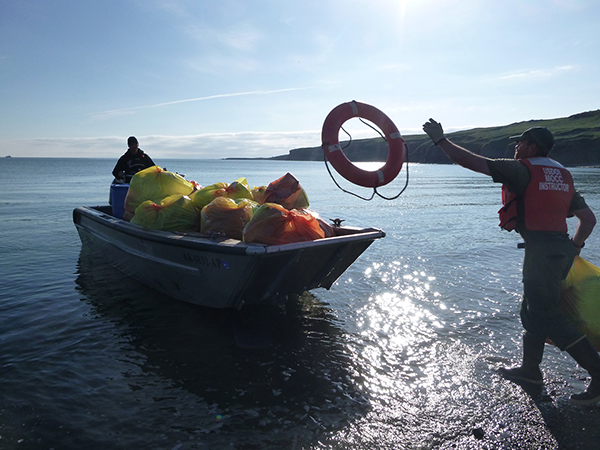News Release

NPS Photo by K. Nicolato
News Release Date: August 26, 2015
Contact: Sharon Kim, 907-422-0546
Gulf of Alaska, Alaska - In the Gulf of Alaska, over 21,800 pounds (10.9 tons) of marine debris were removed from a total of 25 coastline miles across Wrangell-St. Elias Park and Preserve, Kenai Fjords National Park, and Katmai National Park and Preserve with help from numerous volunteers and cooperators. Marine debris includes plastic remnants, building materials, and any other non-natural, solid material that end up in the ocean. This unnatural debris can affect marine mammals and birds directly through entanglement, strangulation, and digestive blockage. Additionally, plastics and Styrofoam can break apart into pieces small enough to enter the food chain. In Alaska, winter storms push the debris hundreds of yards upland where the debris directly impacts terrestrial wildlife; during park cleanups, for example, bear teeth marks are frequently seen on plastic and Styrofoam items.
Across the three national parks, a large number of partners worked together to make these removals successful. Overarching partnerships across all the parks included the National Park Foundation, who funded the bulk of the project out of their Coastal Settlement Funds; Alaska SeaLife Center, who collected the data and will conduct the data analyses; and Alaska Airlines, who donated 10 round-trip tickets to the Gulf of Alaska project (as well as to a Western Arctic marine debris project). Oceans Alaska Science and Learning Center, another National Park Service (NPS) organization, also helped to coordinate the Gulf of Alaska project.
Local volunteers and partners for each park greatly expanded the debris collections effort and amounts as well:
- Wrangell-St. Elias worked closely with youths from the Yakutat Tlingit Tribe and Youth Conservation Corps, as well as interns from the Student Conservation Association and Alaska Native Science and Engineering Program (ANSEP), who helped pickup and sort the debris.
- Kenai Fjords worked with volunteers from Resurrection Bay Conservation Alliance who helped bag and sort the marine debris, as well as Port Graham Corporation who allowed access to their lands within park boundaries for beach clean-ups.
- Katmai partnered with boat operators for the M/V Ursus and M/V Waters to help remove marine debris from Ninagiak Island.
Additionally, there was a large Gulf of Alaska project extending from Kodiak to British Columbia occurring at the same time coordinated by the non-profit organization, Gulf of Alaska Keepers. This larger project was funded by State of Alaska Department of Environmental Conservation, National Oceanic and Atmospheric Administration, and originally funded by the Government of Japan. Gulf of Alaska Keepers working with Waste Management, Inc. coordinated barge transfer of the marine debris super sack caches from Kodiak through British Columbia.
The park beach clean-ups started in late May at Kenai Fjords and Katmai, and continued through June for Wrangell-St. Elias. For Katmai, super sacks were transported by boat in June from park beaches to Kodiak to be loaded onto this marine debris barge. For Kenai Fjords and Wrangell-St. Elias, helicopters transported super sacks directly from park beaches onto the barge in mid-July. In early August, the barge with marine debris super sacks from the Gulf of Alaska beaches arrived in Seattle. The marine debris is being recycled and taken to a Waste Management landfill - the final conclusion to this many layered, multi-park, and multi-partnered project.
Partnering across these two large projects greatly facilitated removing this amount of marine debris from Wrangell-St. Elias, Kenai Fjords, and Katmai national parks with their challenging, remote park beaches. To reduce the amount of plastics and Styrofoam in the environment, the parks will continue working together to collect marine debris along the Alaska coastline but encourage everyone to do their part to lessen marine debris by simply reducing the use of disposable packaging, reusing plastic containers, and recycling in homes to keep litter from ending up on coastal beaches.
*Other NPS contacts:
-For Katmai National Park and Preserve, contact Carissa Turner, 907-246-2104, carissa_n_turner@nps.gov.
-For Wrangell-St. Elias National Park and Preserve, contact Miranda Terwilliger, 907-822-7232, miranda_terwilliger@nps.gov.
-For Alaska Regional Office, contact Tahzay Jones, 907-644-3442, tahzay_jones@nps.gov.
-For Ocean Alaska Science and Learning Center, contact Benjamin Pister, 907-422-0501, benjamin_pister@nps.gov.
Last updated: May 4, 2017
